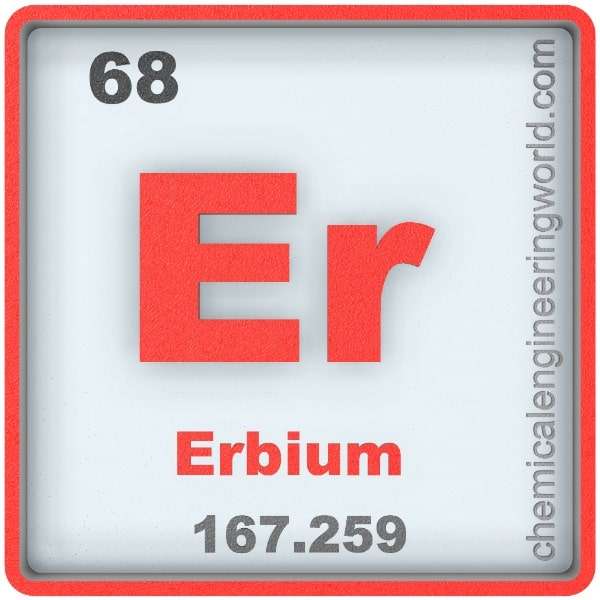Erbium Element Properties and Information

Erbium Element Properties and Information
Erbium is 68th element on the periodic table. Elements are arranged in the periodic table on the basis of the atomic number. Atomic number is the number of protons in the nucleus of the atom. Erbium has an atomic number of 68. It is located in the Group ‘Lanthanides’ and Period 6 of the periodic table of elements. It is denoted by ‘Er’. It is named after Ytterby, Sweden.
Carl Gustav Mosander separated two new metal oxides from Yttrium-oxide in 1843, Erbium-oxide was one amongst the two, and the other was Terbium-oxide. The separated sample of erbium was not completely pure, Jean-Charles Galissard de Marignac separated Ytterbium from erbium in 1878, and this sample of ytterbium was also not completely pure. Wilhelm Klemm and Heinrich Bommer are credited for obtaining pure erbium metal in 1934 by heating pure erbium chloride with potassium.
Erbium is never found in nature as a free element. Its concentration in Earth’s crust is 2.8 ppm. The principles ores of erbium are euxenite and xenotime, it also occurs with other lanthanides in the ores; bastnaesite and monazite.
Physical Properties
- Erbium is a soft and malleable metal. Its appearance is silvery-white after its immediate separation to pure metal.
- The atomic mass of erbium is 167.26.
- The melting point of erbium is 1522°C.
- The boiling point of erbium is 2510°C.
- The density of erbium is 9200 in S.I. units at 20°C.
- Erbium is relatively stable in air and does not oxidize as quickly as other lanthanides.
- Erbium oxide is pink in colour and erbium salts are rose-pink in colour.
- Erbium’s properties quite highly depend on the impurities present in it.
- Below 19K, erbium is ferromagnetic. Between 19-80K, it is antiferromagnetic. Above 80K, it has paramagnetic ordering.
- Naturally occurring erbium is composed of 6 stable isotopes; erbium-162, erbium-164, erbium-166, erbium-167, erbium-168, and erbium-170.
Chemical Properties
- Erbium metal retains its luster in dry air and tarnishes in moist air.
- Erbium metal burns readily to form erbium(III) oxide.
- Erbium metal reacts with water to form its hydroxide. It reacts slowly with cold-water and faster with hot-water.
- Erbium metal reacts with all the halogens to form corresponding trihalides.
Methods of Production
Ion-exchange & Reduction: The crushed ore is treated with hot-concentrated sulphuric acid to get dissolved sulfates of lanthanides. The acid filter is neutralized using sodium hydroxide at pH 3-4, during this process; the thorium gets removed as a hydroxide. The solution is then treated with ammonium oxalates to get lanthanide oxalates. The oxalates are converted to oxides by annealing. The oxides are then dissolved in nitric acid solution wherein cerium gets removed because of its insolubility. The solution is then treated with magnesium nitrate to produce a crystrallized mixture of double salts of lanthanides. The salts are separated using ion exchange chromatography. The rare-earth ions are them selectively washed out using suitable complexing agents. The erbium metal is then obtained from its salts or oxides by heating with calcium in argon atmosphere at 1450°C.
Relevance in Chemical and Related Industries
- Metallurgy: Erbium is used as component in alloys. Vanadium-erbium alloys have low hardness but high workability. Erbium-nickel alloys have unusually high specific heat capacity at liquid-helium temperatures.
- Pigment: Erbium oxide is pink in colour and is used in porcelain, glass, cubic zirconia.
Relevance in Other Industries
- Laser: Erbium-doped yttrium aluminium garnet (Er:YAG) laser is specially used in large variety of medical applications because it is highly absorbed in water. Shallow deposition of laser in the tissues is needed in laser surgeries.
- Optics: Erbium-doped fiber amplifiers (EDFAs) are widely used for optical communications, it consists erbium-doped optical silica-glass as active element.
- Nuclear application: Erbium is used in nuclear reactors as neutron-absorbing control rods.
Health Effects on Exposure
Toxicity: Metallic erbium is slightly toxic in nature but erbium-compounds are non-toxic.
Effects on Surroundings
Erbium poses no harm to plants, animals, and environment.
References:
https://en.wikipedia.org/wiki/Erbium
https://www.lenntech.com/periodic/elements/er.htm
https://www.rsc.org/periodic-table/element/68/erbium
































